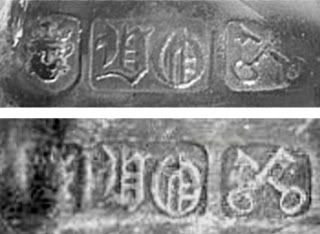Tonomachi wrote:This first hallmark means London according to a couple of Internet British silver mark reference sites I visited. I could use help with the second (maker) and third hallmark.
Hi there. The old 'uns are often the best 'uns <g>, and you've been seduced by an almost iconic Old Sheffield Plate -- sterling silver fused by heat on to copper, rolled into sheets and worked like silver, 1743 - c.1855, aka "OSP" -- pseudo mark, by design luring the unwary into thinking it's sterling assayed by the London Assay Office and marked with its equally iconic leopard's head mark instead. Following the beginnings of regulation of the plate industry in 1784, makers began to register their own maker's marks at assay, and you have the potential good fortune to have an equally iconic OSP maker's mark on your piece, the final crossed keys mark. First registered, with a square cartouche, in 1784 by J. Parsons & Co in a form that has the handles topmost in the mark, it was registered in 1799 by a former partner in Parsons, John Green, under the name John Green & Co., now with the handles inverted, again in a square cartouche. Finally, it was adopted one more time, in the same orientation, by Henry Wilkinson, now in a heraldic shield cartouche, in 1836. Wilkinson preserved the mark in use well beyond the OSP days, as a trademark alongside the "HW&Co" maker's mark for their electroplated silverware, but not used with their sterling silver marks, until the company's demise in 1894. It is Wilkinson's mark we are potentially dealing with here.
There's a catch: the mark is slightly faulty, which can indicate counterfeit OSP, the numbers of which are legion, with early (and not so early) makers of the much cheaper electroplated silverware, mid to late 1840s, trying to masquerade their wares as OSP in order to rip their customers off, plain and simple. Fortunately, I have genuine Wilkinson OSP here of 1836-38 vintage to benchmark your marks against. (photos below) As you can see, at first glance all the marks agree: the
faux crowned leopard's head pseudo mark, the probable craftsman who actually made it, his initials in gothic script ("DG") in a single punch, and finally the crossed keys. As mentioned, Wilkinson's cartouche was an heraldic shield with a downward point at the bottom. Here the marks diverge, for yours looks plain rectangular instead. That would suggest the Green mark of 1799 except for the fact that, like Parsons before him, his crossed keys were always used in conjunction with a slim, rectangular cartouche immediately to the left of them with "I. Greene & Co" inside in normal uppercase print. Unlike his later marks, Wilkinson's OSP maker's mark was the shielded crossed keys *only*. There were no initials or other defining scripted marks of his, used in conjunction.
The shape of the cartouche is not the only detail in these 3 marks that could cast doubt on provenance for your piece to be a genuine Wilkinson one. When you regard the 'leopard's head' punch, the crown and the shape of the ears below it are 'not quite right' either. From what is left of the craftsman's punch, the initials could be credible but a clearer picture could probably help define that better.
There are other characteristics of OSP that can help identification and further photographs homing in on those (e.g. the armorial inside the dish, the rope silver wire finish to the edge, the condition of the gilding), as well as on the crossed keys mark itself, could probably help bolster or undermine whether your little piece is the genuine article or not. If you would like to pursue this further, I'll happily provide you with suggestions on what to take pictures of and how, as well as one or two simple, practical tests to apply to the piece. Just let me know.
Hope this helps some of the way at least.
All the best,









